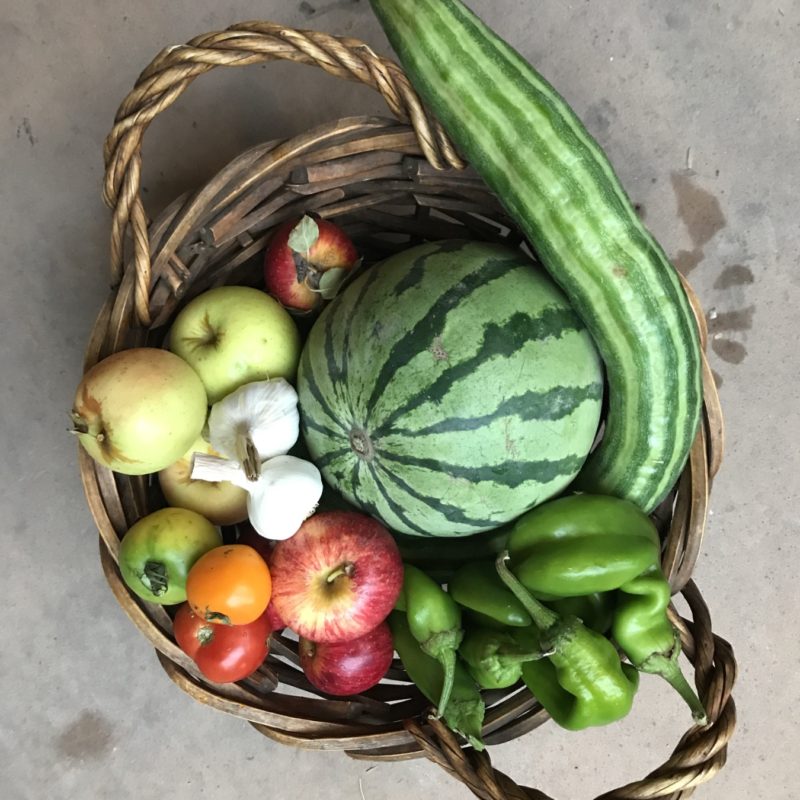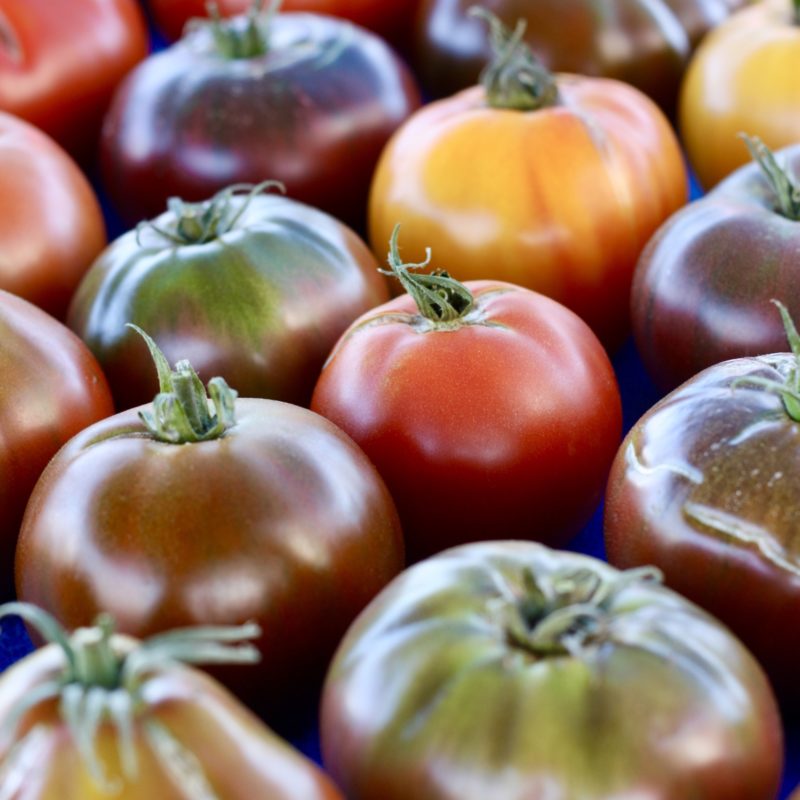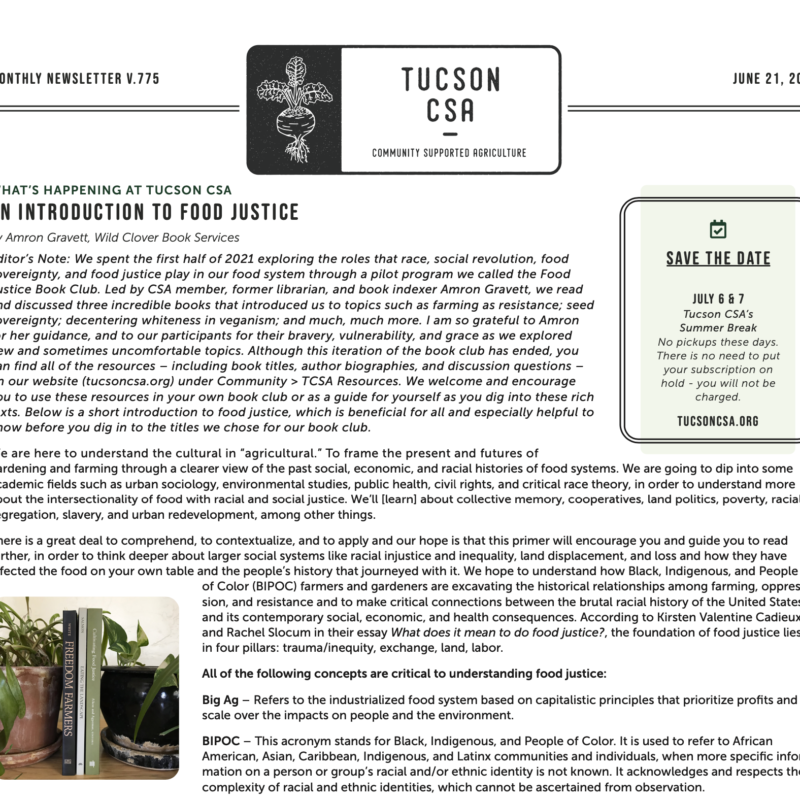
What’s Happening at Tucson CSA
An Introduction to Food Justice

Editor’s Note: We spent the first half of 2021 exploring the roles that race, social revolution, food sovereignty, and food justice play in our food system through a pilot program we called the Food Justice Book Club. Led by CSA member, former librarian, and book indexer Amron Gravett, we read and discussed three incredible books that introduced us to topics such as farming as resistance; seed sovereignty; decentering whiteness in veganism; and much, much more. I am so grateful to Amron for her guidance, and to our participants for their bravery, vulnerability, and grace as we explored new and sometimes uncomfortable topics. Although this iteration of the book club has ended, you can find all of the resources – including book titles, author biographies, and discussion questions – on our website (tucsoncsa.org) under Community > TCSA Resources. We welcome and encourage you to use these resources in your own book club or as a guide for yourself as you dig into these rich texts. Below is a short introduction to food justice, which is beneficial for all and especially helpful to know before you dig in to the titles we chose for our book club.
We are here to understand the cultural in “agricultural.” To frame the present and futures of gardening and farming through a clearer view of the past social, economic, and racial histories of food systems. We are going to dip into some academic fields such as urban sociology, environmental studies, public health, civil rights, and critical race theory, in order to understand more about the intersectionality of food with racial and social justice. We’ll [learn] about collective memory, cooperatives, land politics, poverty, racial segregation, slavery, and urban redevelopment, among other things.
There is a great deal to comprehend, to contextualize, and to apply and our hope is that this primer will encourage you and guide you to read further, in order to think deeper about larger social systems like racial injustice and inequality, land displacement, and loss and how they have affected the food on your own table and the people’s history that journeyed with it. We hope to understand how Black, Indigenous, and People of Color (BIPOC) farmers and gardeners are excavating the historical relationships among farming, oppression, and resistance and to make critical connections between the brutal racial history of the United States and its contemporary social, economic, and health consequences. According to Kirsten Valentine Cadieux and Rachel Slocum in their essay What does it mean to do food justice?, the foundation of food justice lies in four pillars: trauma/inequity, exchange, land, labor.
All of the following concepts are critical to understanding food justice:
Big Ag – Refers to the industrialized food system based on capitalistic principles that prioritize profits and scale over the impacts on people and the environment.
BIPOC – This acronym stands for Black, Indigenous, and People of Color. It is used to refer to African American, Asian, Caribbean, Indigenous, and Latinx communities and individuals, when more specific information on a person or group’s racial and/or ethnic identity is not known. It acknowledges and respects the complexity of racial and ethnic identities, which cannot be ascertained from observation.
Environmental Justice – A term used to refer to the fair treatment and meaningful involvement of all people regardless of race, color, national origin, or income, with respect to the development, implementation, and enforcement of environmental laws, regulations, and policies.
Environmental Justice Movement – Was started by individuals, primarily people of color, who sought to address the inequity of environmental protection in their communities.
Food Justice – Refers to “the right to grow, sell, and eat [food that is] nutritious, affordable, culturally appropriate, and grown locally with care for the well-being of the land, workers, and animals.” (Alkon and Agyeman 2011, 5)
Food Justice Movement – Is a grassroots initiative emerging from communities in response to food insecurity and economic pressures that prevent access to healthy, nutritious, and culturally appropriate foods.
Food Sovereignty – Means a community’s right to define their own food and agriculture systems. (Alkon and Agyeman 2011, 8)
Food insecurity – Lacking access to a sufficient quantity of affordable, nutritious food. For example,
Food Desert – “Area[s] with limited access to affordable and nutritious foods, particularly such an area composed of predominantly lower income neighborhoods and communities.” Also known as “food apartheid”, which is a more comprehensive term that looks at the whole food system, along with race, geography, faith, and economics.”
Save the Date
Tucson CSA’s Summer Break
No pickups on July 6 & 7. There is no need to put your subscription on hold – you will not be charged.
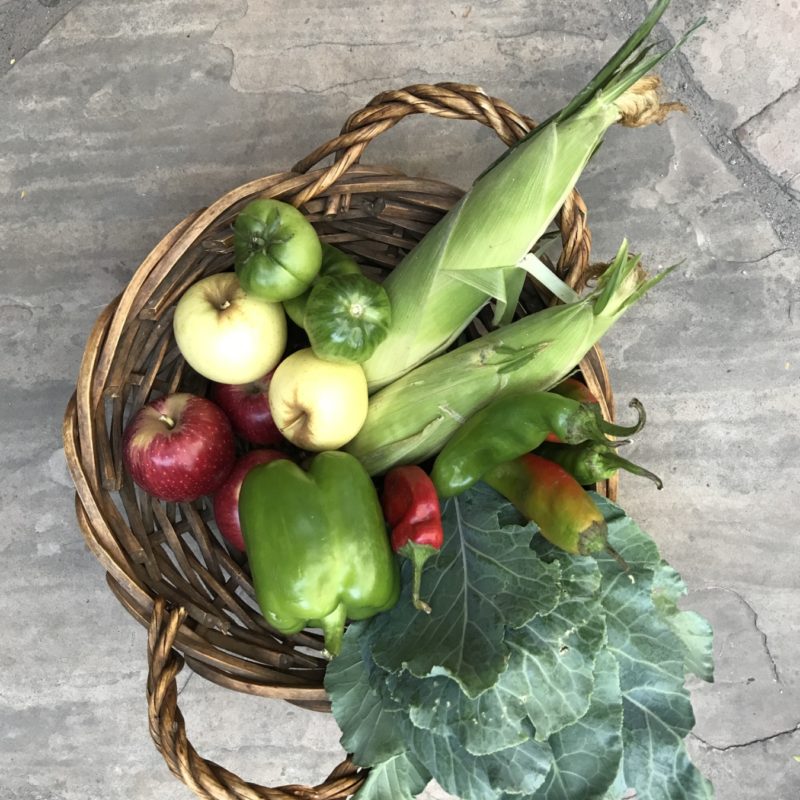
Produce Spotlight
Yardlong Beans (AKA Dow Gauk, Sasage, Asparagus Bean)
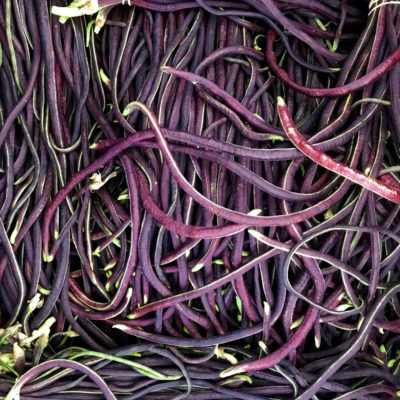
Known as dow gauk in China, sasage in Japan, and either yardlong or asparagus bean in England and the US, this close relative of southern peas (think black-eyed peas, purple hull peas, and crowder peas) grows well in the summer heat. Yardlong beans grow quickly and can grow up to three feet long but are typically harvested when they’re anywhere from 12-18” long. Similar to string/green beans, yardlong beans are harvested before they’re fully mature, preserving their tenderness and enabling us to eat them fresh, without soaking or cooking for a long period of time.
Yardlong beans have a strong bean flavor and can become quite tender and pleasant when they’re cooked well. Unlike string/green beans, yardlong beans soak up a lot of water and can become waterlogged if they’re boiled, blanched, or steamed. The best way to prepare them is to cut them into two-inch pieces and cook them in a hot skillet with oil. They’re great in a stir fry with other summer produce like eggplant and peppers, or prepared more traditionally by dry frying them, Sichuan-style. Their absorbency can be used to your advantage, too, if you choose to cook them in a rich coconut curry with lots of aromatics like ginger, garlic, lemongrass, and chiles.
We’re Reading
Black Entrepreneurs Sow Seeds Of Healthier Eating During Pandemic Gardening Boom NPRWe’re Listening To
The Link Between Anti-Racism Work and Ending Diet Culture Food Psych Podcast with Christy HarrisonWe’re Reading
Dehydrated Meals for Backpacking and Camping! Miranda in the WildOn Social
Merchant’s Garden InstagramProducer Spotlight
Merchant’s Garden
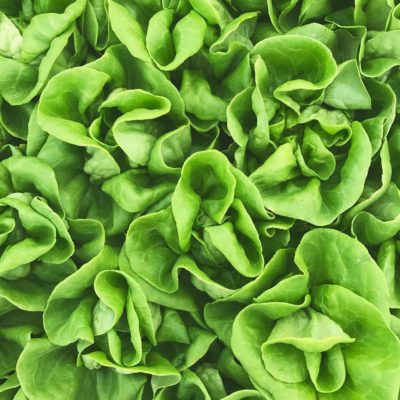
Over the course of the past two months, as temperatures rose higher and higher, Tucson CSA members found a welcome sight in their shares: delicate whole lettuce with roots still attached. Those who garden know that it’s too hot to get lettuce to germinate starting in April, so where did those delectable and cool leaves come from?
Merchant’s Garden is a passion project. Chaz Shelton was motivated to found the enterprise by his experiences in health care, where he observed the crying need for healthy food. He and his father started Merchant’s Garden in 2015 and were able to attract other investors.
The model is innovative and ingenious. The fish known as tilapia grows in tanks on the property at 555 S. Tucson Boulevard, in what was once a TUSD school. The water containing their waste product is triple filtered in UV tubing and routed to a vertical aquaponic growth structure planted with many kinds of greens and an amazing variety of fresh herbs. The underlying philosophy is one that CSA members will recognize, in which the grower tries to maximize food production while still preserving the sustainability of the land. It is said that this method of producing food uses less water than growing in earth.
It didn’t take long for Tucson’s chef community to realize that Merchant’s Garden was a great resource for both tasty greens and fresh, never frozen tilapia here in the middle of the desert. Many area restaurants feature the red and green leaf lettuce, Thai basil, and zesty mustard greens from the business. Merchant’s Garden also hosts a farm stand at their property where they sell to individual consumers. (They accept SNAP and Double Up Food Bucks!) You can visit their farm stand on Thursdays and Fridays from 9 a.m. – 2 p.m. and on Saturdays from 8 a.m. – 12 p.m.
You can learn more at MerchantsGarden.com or on Facebook and Instagram @MerchantsGarden.
